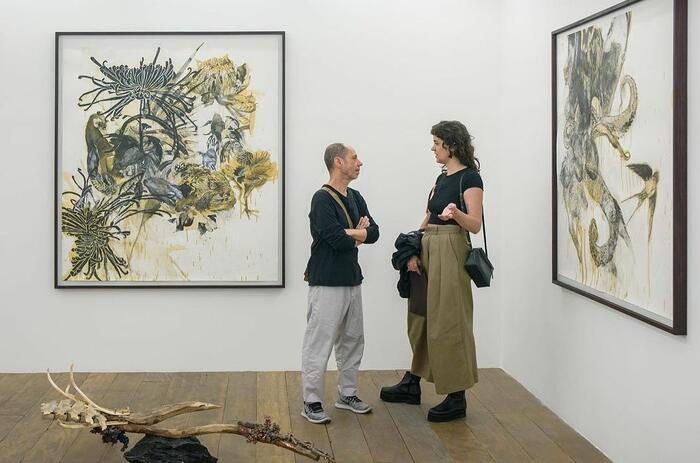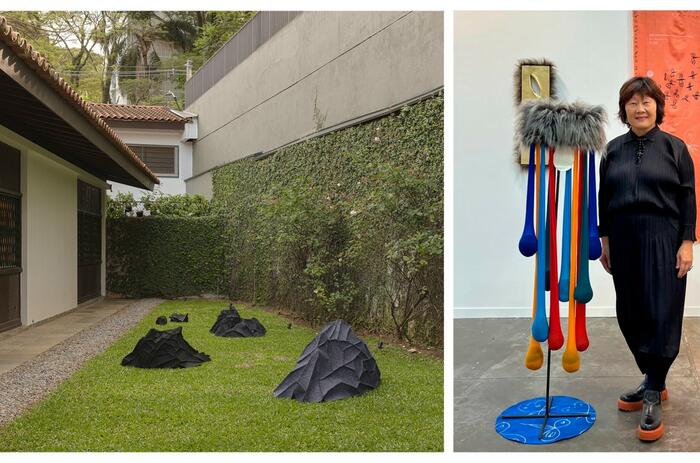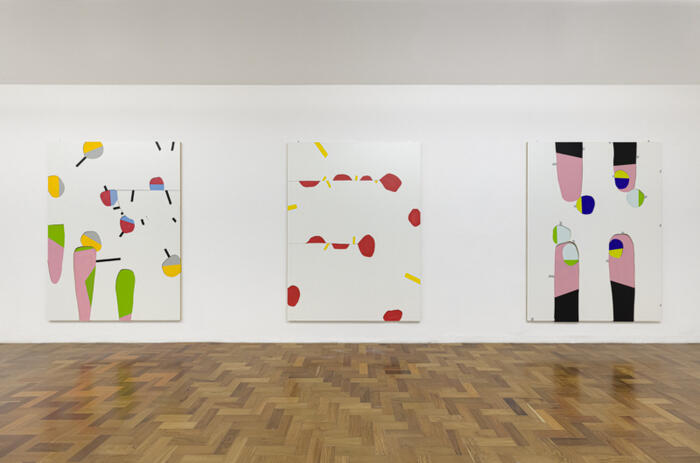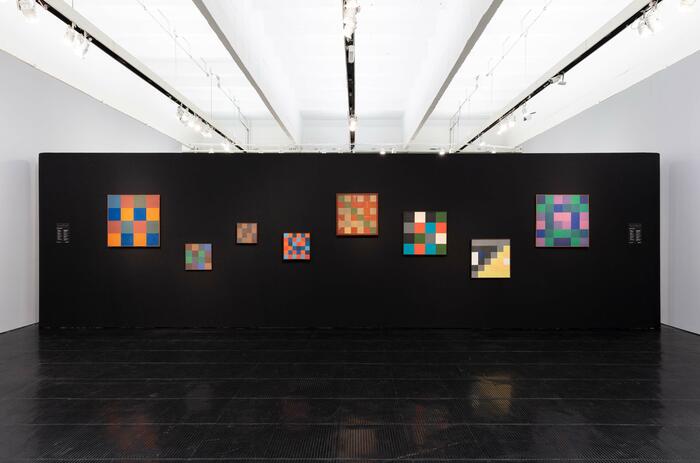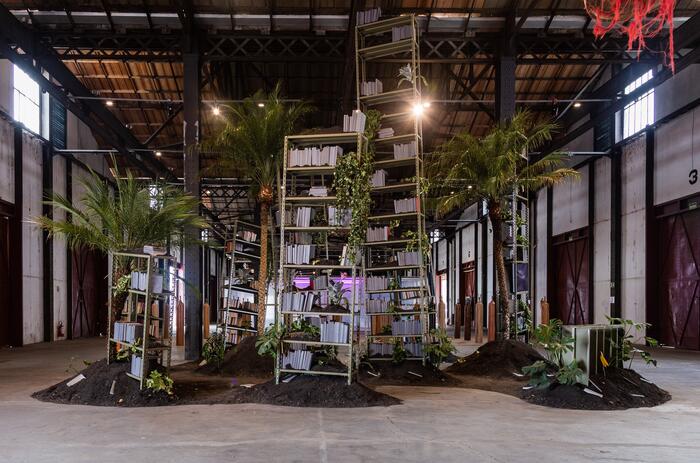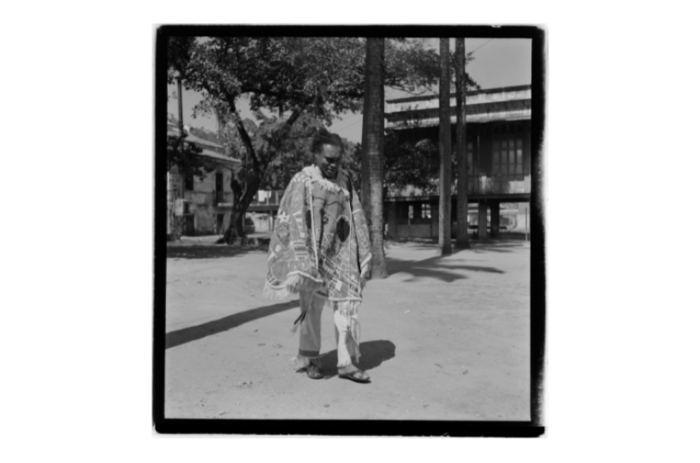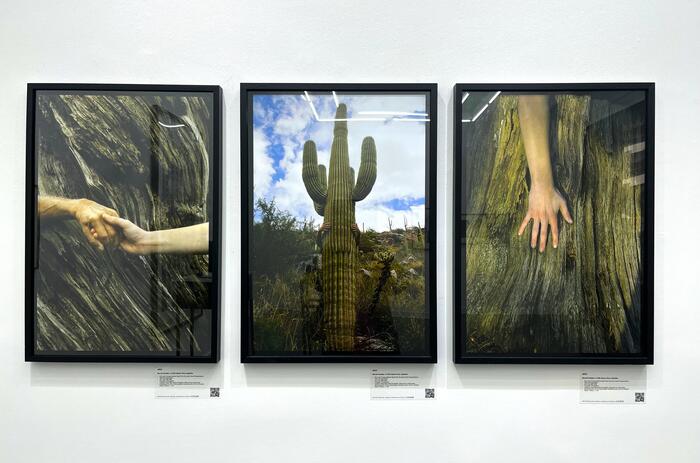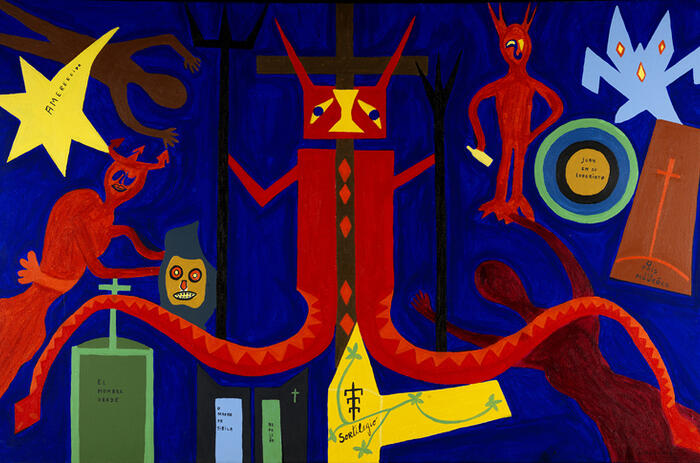DESIRE, TRANCE AND SHAPPER – JONATHAS DE ANDRADE IN ‘THE WORLD IS THE THEATER OF MAN’ AND ‘POUNCE AND BOUNCE’

This is one of the unique moments of the most recent contemporary art in Brazil. The final tracking shot of Olho da Rua, a video by Jonathas de Andrade now on display at Inhotim, one of Brazil's leading visual arts centers, is one of those happy moments in which the artist manages to capture with such precision the zeitgeist of his country (in this case, on a continental scale). A lacerated, divided Brazil, a constant target of successive and acute conflicts in the last four years – and which had another surprising and sad chapter on January 8, when the headquarters of the three constitutional powers were subjected to excessive violence by sympathizers in green and extreme right in yellow.
There is a reaction, poetic and seminal, from a population made invisible and more vulnerable than ever in recent years, and this spills over into the extrafield of production. The slow motion movement becomes, in fact, an exciting libel against inequality, in favor of inclusion, of the plural, of the diverse. However, the device is not supported by more common politicized discourse. This multicultural myriad of faces, bodies and boiling existences is captured, with folds, marks, defects, scars, rags and tears of this popular soul, to the sound of Homero Basilio's powerful percussive soundtrack, as if announcing a state of revolution led by for the northeast – not that cordial recorded in the pen of Gilberto Freyre (1900-1987) and other similar theorists, who minimized structural wounds in Brazilian history, such as racism and privilege in various spheres of local elites.
Bearing in mind that the Northeast was the first region to be colonized in Brazil, it suffers to this day from such early dispossession, and is the focus of prejudice by the inhabitants in the South-Southeast, who today find themselves in an apparently more prosperous economy. And the idea of the man from the Northeast, popularly, has to do with virility – a stereotype with which the artist does an elaborate job of deconstruction – sometimes in a more direct way, as in the series Carteles del Museu do Homem do Nordeste, sometimes more playfully, exemplified in the surprising collection of swimsuits abandoned in public swimming pools, which the artist rearranges in the installation Achados e Perdidos. Both works are part of O Rebote do Bote, a panorama curated by Ana Maria Maia that is currently on display at the Pinacoteca de São Paulo.
-
Museu do Homem do Nordeste, 2013. Jonathas de Andrade: On Fishes, Horses and Man exhibition view, The Power Plant, Toronto, 2017. Photo: Toni Hafkenscheid.
In any case, this rebellion in Olho da Rua did not break out with the tools of war but materialized through these micro-stories, sometimes forgotten in the degraded and damaged centers of the large Brazilian cities, which, however, became the focus of a more intense, firm and lasting resistance, even when achieved with less ostensive resources and tools. The audiovisual was set in the Hipódromo square, in the center of Recife, with a cast of about one hundred people, not actors, coming from initiatives related to the homeless population, which has visibly increased in the great Brazilian city in recent times.
Olho da Rua is exhibited at Inhotim as part of the collective exhibition O Mundo É o Teatro do Homem, which also presents another video by Barbara Wagner and Benjamin de Burca, as well as documentary material on proposals from the Theater of the Oppressed, by Augusto Boal (1931 -2009), and Teatro Experimental do Negro, directed by Abdias Nascimento (1914-2011). It attests to the good moment of Jonathas, who, without a doubt, is today one of the main names on the visual circuit in the country and abroad. In addition to his prominent presence at the Minas Gerais cultural center, he had an impressive showing at the Pinacoteca de SP, a major museum in Brazil's largest city, and represented the country in the national pavilion at the 59th Venice Biennale last year. That production was previously shown in the parallel program of the Italian event, within the Penumbra collective, based at Complesso dell'Ospedaletto.
Com o Coração Sainto pela Boca, a project that Jonathas presented at the Biennale (which had a theme somewhat linked to surrealism, The Milk of Dreams) reinforces the ambivalence of his aesthetic program, a theme dear to him, and, at the same time, questions the very representation of his native country within an international exhibition in a circuit with so many flows, circulations and exchanges.
Curated by São Paulo-based Italian Jacopo Crivelli Visconti (34th SP Biennial), the cut was based on three-dimensional images of generous volumes and scales - supported by the carnivalesque aesthetic of both Carlos Brassesco, from the Italian city, and Silvio Botelho from the Olinda festivals, on the periphery of the artist's affective Recife - almost spilling pieces of a collective body to literally translate popular Brazilian expressions.
“These isolated and objectified parts of a body also transcend it, by introducing another structuring element of the exhibition and of Jonathas's work as a whole: language,” Visconti writes in the exhibition catalogue. “I present a project called With the heart coming out of the mouth, understanding that I speak of language as a collective metaphor of a body that is collectively oppressed, crushed, mistreated and suffocated by the present”, says Jonathas himself, in an interview with Gabriela Longman for the website of the SP Art fair.
And Maia's careful curation of O Rebote do Bote at the São Paulo museum ranges from lesser-known works in the artist's career to pieces that are already highly visible. Not anchored in chronological criteria, the anthology thus manages to surprise points even for those who have followed Jonathas for years. “Thus, in addition to the imaginary and objective balance of the artist's career, an adequate understanding of his work requires recognizing the relationships that he unleashes in order to work”, he states in the text of the exhibition.
-
Jonathas de Andrade, Ressaca Tropical (ao fundo) e Achados e Perdidos. O Rebote do Bote, Pinacoteca de São Paulo. Crédito: Christina Ruffato
-
O Caseiro, 2016. Jonathas de Andrade.
-
Jonathas de Andrade, HoyAyer. O Rebote do Bote, Pinacoteca de São Paulo. Crédito: Christina Ruffato
-
O Levante, v1. Jonathas de Andrade.
The public can, logically, review masterpieces by Jonathas, such as the disconcerting photographic polyptych Tropical Hangover and the accurate political criticism of the video The Housekeeper. Of course, attention to the 'little ones' Tide,The Clube, Designing the Opening of a Home as It Could Be and HoyAyer, for example. And there is, in the middle of all the instigating group, the subversion of projects such as O Levante, which mobilized numerous drivers from the periphery of the capital of Pernambuco, prohibited from driving through the city, and who end up participating in a race in the center of the metropolis with the purpose of participating in a filming.
Exclusion and mobilization, in which it is difficult to determine what is traditional and what is new, the complex coexistence of different urban actors, developmentalism and occupation, among others, are vectors of poetic force managed by the multiple actions of Jonathas de Andrade, to persistently build a body of work that is always interesting and far from complacent.
O Mundo É or Teatro do Homem (The world is the theater of man)
Until July 16, 2023
Inhotim - Rua B, 20, Brumadinho, MG, Brazil.
O Rebote do Bote (Pounce and Bounce) - Jonathas de Andrade
Curator: Ana María Maia
Until February 28, 2023
Pinacoteca of the State of São Paulo.

